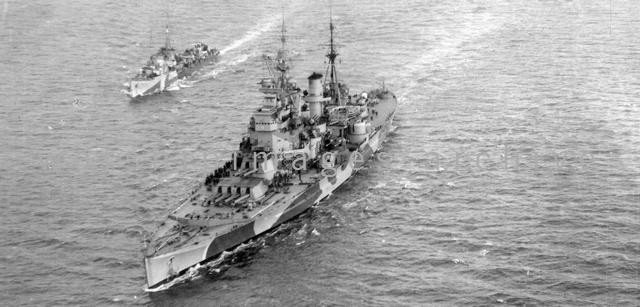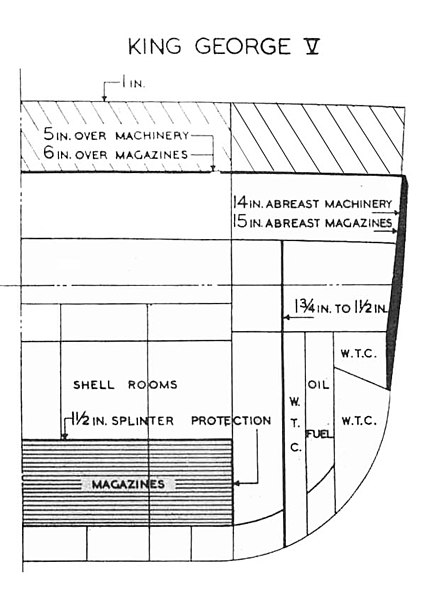- Yes
- No

Class History
Spoiler
The King George V class were Britain’s second class of Treaty Battleships, and the first new design drawn up for the Royal Navy since the Treaty had been signed. Though they were technically succeeding the Nelson class Battleships, the two classes were intended to serve together with the KGV class replacing the Revenge class Battleships and, after the escalator clause had been invoked, the Lion class was intended to enter service with a similar layout, but improved main battery.
A notable feature of these ships were the two quadruple turrets. Though first envisaged with three triple 15-inch turrets in a more traditional layout, the class instead featured a 10-gun 14-inch main battery in a 4-2-4 configuration, with the twin turret superfiring over the fore quadruple turret. With a 35,000 tonne limit, the Admiralty felt that 16-inch guns such as on the Nelson class could not provide a balanced ship with a satisfactory mix of speed, armour and firepower. 15-inch guns in triple turrets were then settled upon and drawn up, however because Britain had been pushing for a new naval treaty which had a new 14-inch limit to the main battery, as a result they would be downgraded yet another inch to 14-inch weapons and as naval guns are long-lease items, they were ordered and began construction before the escalator clauses were invoked in 1938. Although originally it would have be 3 quadruple turrets in the same configuration, now the superfiring turret lost 2 guns to save weight.
The King George V class would from this point emphasise armour to offset the power found on newer ships and ships with 16-inch guns. This was more than satisfied as they would be the most heavily armoured ships per tonne ever constructed with the Yamato having a thicker belt, but near twice the displacement, this was furthered as Britain had developed significantly improved armour metrology techniques found only otherwise in Germany. This yielded an 8-25% increase in armour effectiveness in reference to those outside of the UK.
The ships also featured significant bursting charges for its 14-inch shells and the KGV’s broadside weight was very comparable to that of Bismarck.
5 ships would be constructed with the first being commissioned in 1940 as the class leader HMS King George V, with Prince of Wales shortly following her in 1941 and the other three (Duke of York, Anson and Howe) joining the fleet within 13 months of Prince of Wales.
They would see action throughout the war and King George V and Prince of Wales would both see action in their most famous actions in the hunt for the Bismarck. Only one would be lost, Prince of Wales, due to Japanese air actions which largely would have been prevented if the ships had revised their AA strategy.
HMS KGV Service record
Spoiler
HMS King George V’s record is extensive (although not as extensive as some other British battleships of the era). Her many actions are widely detailed but here are her key actions in WW2.
HMS King George V (KGV) was a battleship of the British Royal Navy that served during World War II. Here is a brief history of its wartime actions:
Early Operations:
- Commissioned in December 1940, HMS King George V initially undertook convoy escort duties in the Atlantic Ocean.
- In May 1941, it participated in the famous hunt for the German battleship Bismarck, which resulted in the sinking of the Bismarck.
Operation Pedestal: - In August 1942, HMS King George V took part in Operation Pedestal, a critical convoy operation to supply the besieged island of Malta in the Mediterranean.
- During the operation, KGV engaged in combat with enemy aircraft and played a significant role in defending the convoy against attacks.
North African Campaign: - KGV was involved in the Allied operations in North Africa, providing fire support during the landings in Morocco (Operation Torch) in November 1942.
- The battleship also took part in the bombardment of enemy positions during the Tunisian Campaign in 1943.
D-Day and Normandy Landings: - In June 1944, HMS King George V played a crucial role in supporting the Allied invasion of Normandy (Operation Overlord) on D-Day.
- It provided fire support to the troops landing on the beaches, targeting German coastal defenses.
Pacific Operations: - After the defeat of Germany, KGV was transferred to the Pacific theater to participate in the war against Japan.
- Due to the surrender of Japan in August 1945, the she did not see active combat in the Pacific.
Specifications

The below specifications are done to the standard of the ship HMS King George V as of September 1945
Displacement
- Standard: 39,100 tons – Deep load: 44,460 tons
Dimensions
- Length: 745ft 0.13in overall – 740ft 0.25in waterline – 700ft 0.25in between perpendiculars
- Beam: 112ft 4.25in max – 103ft 2.56in waterline
- Depth at side: 51ft 1.31in
- Draught (1940): Standard – 29ft (mean), Deep load – 32ft 6in (mean)
Propulsion
- Turbines: 4 x Parsons single-reduction geared, 4 shafts
- Propellers: 4 x 3-bladed manganese bronze 14.5ft diameter
- Boilers: 8 x Admiralty 3-drum small-tube with superheaters
- Working pressure (max): 400lb/sq in
Main Battery Armament
- 10 x 14in, 45 cal. Mk VII guns
Battery performance
Spoiler
- Length of bore: 45 calibres (630in)
- Length of gun: 52ft 6in breech to face muzzle – 54ft 2.8in overall
- Weight of gun (bare): 77tons 14 cwt 84lb
- Weight of gun (with counter-balance): 89tons 2cwt 84lb
- Weight of breech mechanism: 1ton 17cwt
- Rifling: polygroove, 72 grooves plain section uniform right-hand twist of one turn in 30 calibres
- Weight of shell: 1590lb
- Weight of charge: 338lb
- Muzzle velocity: 2475 ft/sec
- Muzzle energy: 67,520 ft/tons
- Barrel life: 375 rounds
- Gun mountings: 1x MkII twin gun turret (forward) – 2x MkIII quadruple gun turrets (1 forward, 1 aft)
- Maximum elevation: 40 degrees
- Rate of fire: 2 rounds per gun per minute
- Max rate of gun elevation: 8 degrees per second
- Max rate of gun training: 2 degrees per second
- Maximum range: 36,300 yards
- Shell stowage: 80 rounds per gun (100 max)
Secondary Battery armament
- 8 x 5.25in, 50 cal. Mk1 quick-firing guns (Same as on HMS Dido)
Anti-Aircraft Battery (1945)
- 8 x 8-barrelled MkVI 2pdr pom-poms
- 24 x single-barrelled MkIIIA 20mm Oerlikons
- 6 x twin-barrelled MkV 20mm Oerlikons
- 2 x 4-barrelled American MkII 40mm Bofors
- 2 x single-barrelled RN pattern 40mm Bofors
Crew complement: 1,300 (peace), 1600 (war).
Armour:
- Main Belt: 14.7 in (373 mm)
- Lower belt: 5.4 in (137 mm)
- Deck: 4.88–5.88 in (124–149 mm)
- Main gun turrets: 12.75 in (324 mm)
- Barbettes: 12.75 in (324 mm)
(This does not account for effective thickness but pure LoS thickness of the armour using commonly cited figures, the armour belt reached ~18-20-inches when armour quality was accounted for).
Pictures:
Spoiler

![HMS Vanguard next to HMS King George V [1,400x1,552] : r/WarshipPorn](https://external-preview.redd.it/G6qM1fwWVVlklVD6fWBqqHv6QLbGnfnCJfUDAtN47Ug.jpg?width=640&crop=smart&auto=webp&s=e11881a71aa2ce9003b51ad0abeb8cdc4478c3b9)

Sources:

